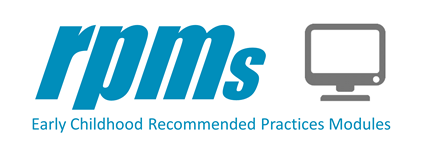Module 1 Learning Guides
These guides are used by and facilitated by instructors with learners. They are designed to extend the learning in the self-paced modules.
General Guides
- For Instructors: RPM Learning and Improvement Framework
- Embedding the Modules into Existing Coursework and Practicum
- Introduction to the RPM Crosswalks
- Interaction Crosswalk
Learning Guides
Guide Name and Description/Objectives |
Related Lesson/Module Section |
| PLAN SECTION | |
|
Learning Guide 1.1: Setting the Stage- Pre-Module With this guide, learners will:
|
Setting the Stage (2:15 run time) Students meet Ms. Karen who has a challenge with establishing positive interactions with a new child in her class. |
|
Learning Guide 1.2: Ask The Expert With this guide, learners will:
|
Lesson 1: Ask the Expert (2:54 run time) Interaction is defined and the best available research on interaction practices is summarized by Dr. Jeanette McCollum. |
|
Learning Guide 1.3: Gathering Information With this guide, learners will:
|
Lesson 2: Gathering Information (17:52 run time) Key features of interaction practices, specifically observing and interpreting are explained with examples and activities. |
|
Learning Guide 1.4a: Take Action With this guide, learners will:
Learning Guide 1.4b: Take Action With this guide, learners will:
|
Lesson 3: Taking Action (13:39 run time) More key features of interaction practices, specifically responding contingently and putting it altogether (i.e., observing, interpreting and responding), are explained with examples and activities. |
|
Learning Guide 1.5: Voices from the Field With this guide, learners will:
|
Lesson 4: Voices from the Field Practitioners and family leaders share their expertise and perspectives of using interaction practices with young children. |
| DO and STUDY SECTIONS | |
|
Learning Guide 1.6: Observations Checklist With this guide:
Learning Guide 1.7: Scenario-Based Activity This guide contains a set of five simulations/scenarios that can be used in place of, or in addition to, the online simulation. With this guide:
Learning Guide 1.8: Reframing Activity With this guide:
Learning Guide 1.9: Practice Dilemmas With this guide:
|
|
| ACT SECTION | |
|
Learning Guide 1.10: Performance Feedback Guide This guide can be used in class when learners are engaged in role-plays or scenario-based activities. Also, this guide can be used when supervising learners in early childhood settings with children. Learning Guide 1.11: Practice Profile Module 1 Interactions Practice Profile connects DEC Recommended Practices for Interactions with how this practice contributes to child outcomes and describes example behavior of practitioners that are associated with each practice. Learning Guide 1.12: Setting the Stage- Wrap-Up With this guide, learners will:
|
Module 1 Act Section |
Got questions? Looking for SCORM-ready lessons to embed in your LMS? Contact rpm@unc.edu
